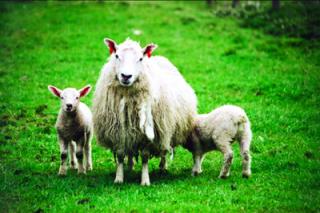Reducing Sheep Stocking Rates Through Improved Fecundity
Published on 16 November 2009 in Ecosystems and biodiversity

Introduction
In many hill and upland sheep production systems there is a need to manage sheep flocks in ways that satisfy both increased economic outputs (through the sale of animals, meat and fibre) and biodiversity objectives. In some situations these two objectives may be reconciled by reducing effective stocking rates through increasing ewe fecundity (i.e number of lambs produced per ewe). This allows the annual output per ewe to be increased through the production of extra lambs thus reducing the need to carry so many animals. By using more fecund animals, the stocking rate during winter, when vegetation is most sensitive to high grazing pressures, can be reduced while animal productivity during the plant growing season is maintained or enhanced.
A gene which has a large effect on sheep fecundity was originally isolated from Icelandic sheep and has since been introduced to Scottish breeds. This gene is named Thoka after the ewe from which the gene appears to have originated. Ewes carrying the Thoka gene produce approximately 0.7 additional lambs per ewe per year. Since this effect is attributable to a single, dominant gene (unlike in many other fecund breeds), it can be introduced to any sheep breed through the use of rams carrying the gene. Thus, breeds which have relatively low fecundity but other qualities which make them suited to a particular production system (e.g. Cheviots in hill and upland systems) can produce significantly more lambs, provided that the nutritional resources during late gestation and lactation are adequate, without any increase in the winter stocking rate. Furthermore, unlike with some other genes for fecundity, this gene seldom results in very large litters (4 or more) which are undesirable from a management perspective.
Key Points
- The Thoka gene for fecundity can increase the productivity of marginal land without increasing winter stocking rates.
- Such an increase in fecundity can increase the efficiency of production in terms of both energy and monetary cost.
- Winter stocking rates can be reduced on marginal land while maintaining output and thus, the adverse effects of increasing stocking density can be avoided.
- The effect is induced by a single dominant gene and so it can be readily introduced to any sheep breed, thereby increasing fecundity without compromising other qualities.
Research Undertaken
The gene was originally introduced from Iceland to a Macaulay Institute Cheviot sheep flock, via semen from carrier rams. Using a multidisciplinary approach involving state-of-the-art statistical techniques and bioinformatics, together with morphological, endocrinological and histological analyses, the occurrence of large litters has been linked to the locus of the relevant gene and the mutation has been characterised (Nicol et al., 2009).
It has been shown that rams carrying two copies of the gene are fully fertile but ewes with two copies are infertile while those with a single copy exhibit an increased rate of fecundity but no other changes in performance characteristics. Infertility in homozygous animals (carrying two copies of the gene) is not inconsistent with the use of the gene in commercial flocks because animals carrying no copies or one or two copies of the gene can be identified with a simple blood test. Mechanisms through which the gene may be exploited in commercial flocks are now being explored in collaboration with a collaborating company while the underlying mechanisms of action are further investigated by collaborating scientists.
Policy Implications
Sheep breeds which are both relatively fecund and adapted to the relatively harsh environmental conditions of hill and upland areas, in particular, represent a mechanism through which viable animal production systems and maintenance of plant biodiversity can be combined because they allow exploitation of a valuable nutrient resource in summer combined with a limited stocking rate in winter. Other sheep production systems may also be enhanced by incorporation of the Thoka gene for fecundity, depending on the specific needs of the system and the characteristics of the breed used. While homozygous females are infertile, existing flock management protocols indicate that this gene can be managed through the creation of breeding flocks carrying one copy, in the same way that the Halfbred ewe is used. The aim is to explore this approach through links with the industry.
References
Nicol, L., Bishop, S.C., Pong-Wong, R., Bendixen, C., Holm, L-E., Rhind, S.M. and McNeilly, A.S. 2009. Fertility in a monovular species is modulated by a novel single amino acid change in oocyte specific GDF9. Reproduction 138 921-933
Author
Dr Stewart Rhind, The Macaulay Land Use Research Institute s.rhind@macaulay.ac.uk





